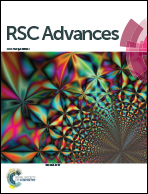A general method to fabricate MoO3/C composites and porous C for asymmetric solid-state supercapacitors†
Abstract
MoO3 is one of the most promising electrodes for high energy density supercapacitors due to its layered structure, which facilitates the insertion/removal of small ions. However, the commercial recognition of MoO3-based electrodes has been hampered by their low electronic conductivity, poor structural stability and narrow working potential window. A MoO3/C composite (MCs) has been synthesized by a polymerization method followed by calcination of the obtained hydrogel. The obtained MCs electrode exhibits remarkable electrochemical performance in both aqueous (432.5 F g−1 at a current density of 0.5 A g−1, 100% capacity retention after 10 000 cycles) and all-solid (220.5 F g−1 at 0.5 A g−1) systems with porous C as the positive electrode, demonstrating its potential in commercial utilization.



 Please wait while we load your content...
Please wait while we load your content...